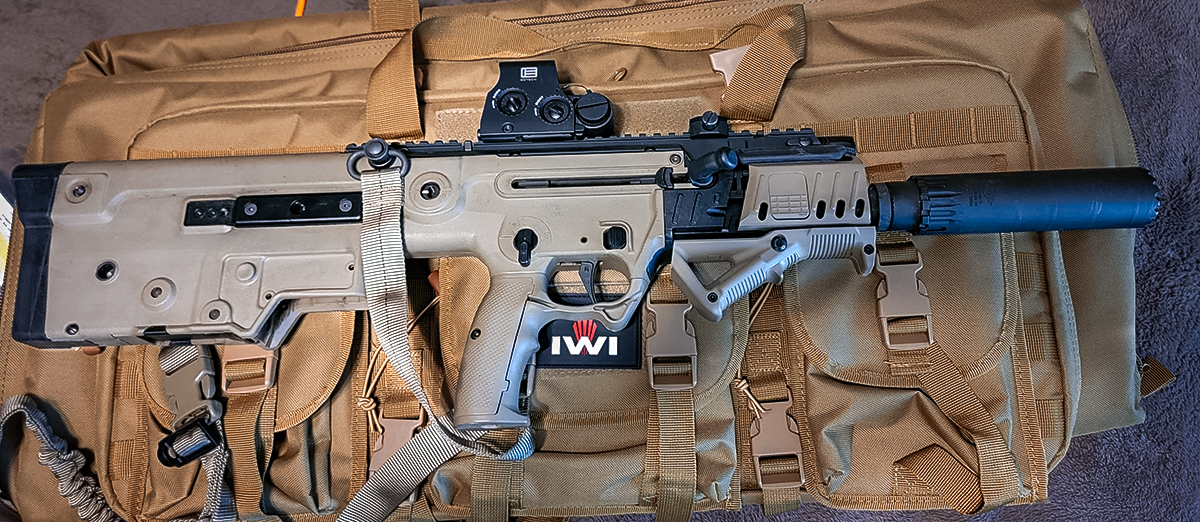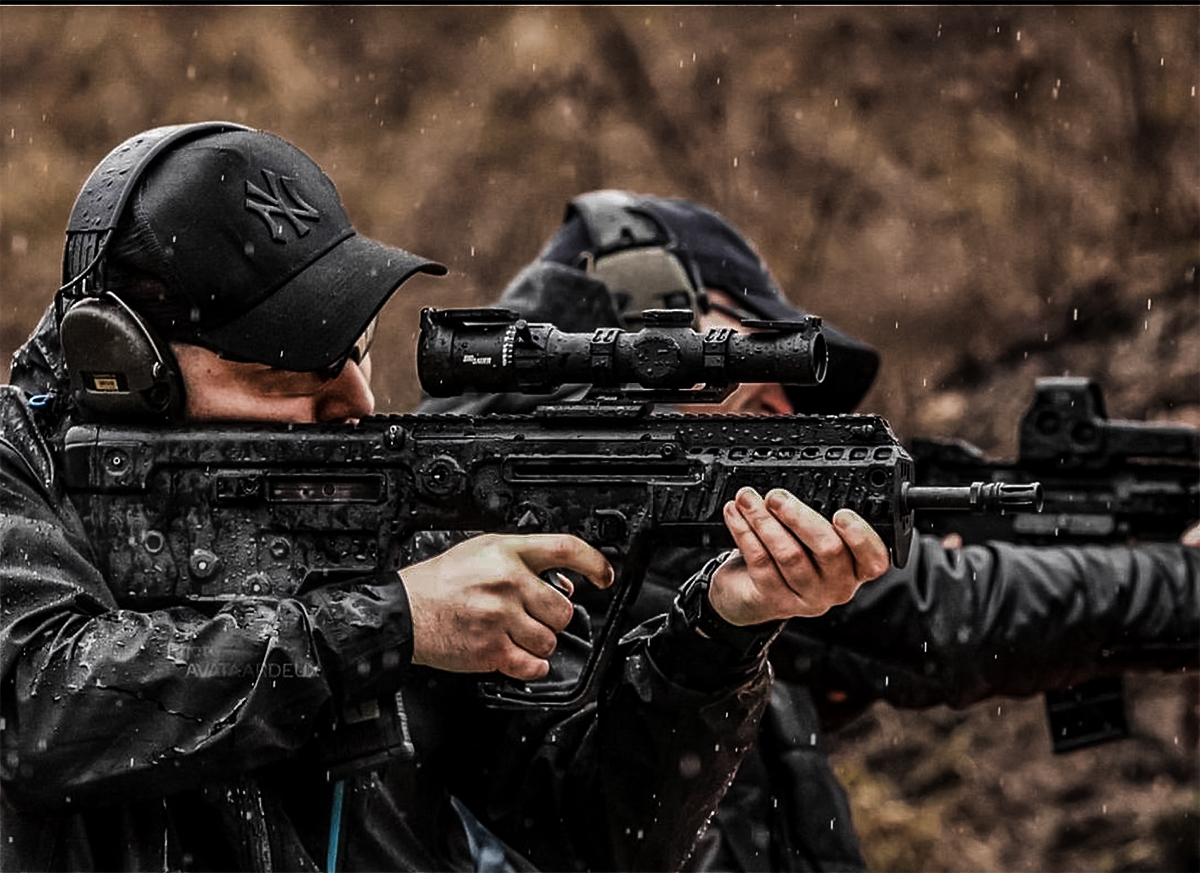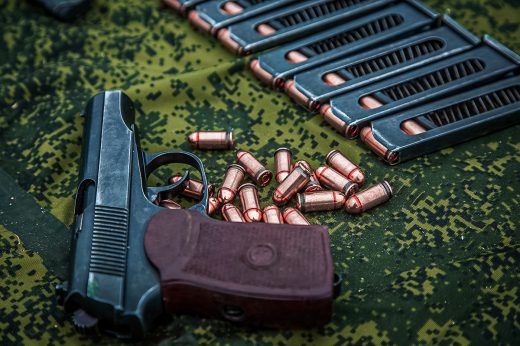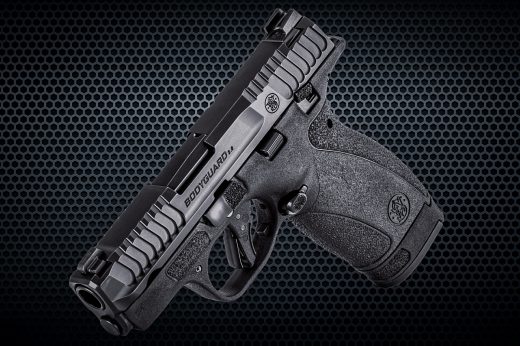People either love or hate bullpups. This isn’t the time or place for that argument. Let’s just assume, for a moment, that we’re all peaceful with the bullpup concept and agree it is a compact and maneuverable design for a carbine. And in the world of semi-auto .223/5.56 bullpups, the IWI Tavor X95 is basically the AR of the niche. It’s the best-designed and most respected rifle platform, not that it has a lot of competition.
The X95 mitigates a lot of the problems that plague the bullpup design, which creates a shorter overall firearm without sacrificing barrel length by moving the action rearward into the buttstock itself. It isn’t perfect by any means, but it’s a damn solid rifle that often doesn’t get the respect it deserves.

The Tavor X95’s Evolution
Israel Weapon Industries began the Tavor line, as far as U.S. customers were concerned, with the release of the Tavor SAR. Elsewhere in the world, it’s known as the TC-21. Both are the semi-automatic-only version of the select fire TAR-21, which is restricted to military and LEO sales. When the X95 hit the scene, it got people’s interest.
It was well-designed, and it felt better than most bullpups did. It didn’t have some of the attributes of other platforms that flirted with success and acceptance — the Tavor doesn’t eject downward like the now discontinued FN FS2000, and it was a completely different profile than the Steyr AUG from the 1970s. But the Tavor had the advantage of being “combat-tested” with the Israel Defense Forces — who were still generally issued M16s and M4s at the time.

Sales in the U.S. picked up, but there were things about the SAR that a lot of American shooters, who were raised shooting ARs, couldn’t get over, and the same went for NATO forces all over the world. IWI responded.
In 2009, the IDF selected the reworked Tavor X95, which was then known as the Micro Tavor or MTAR, to fully replace its M16s and M4 carbines, which were set to be phased out by 2018. However, the gun wasn’t issued until 2013, about the same time it went on sale in the U.S. as the Tavor X95. It was a game-changer.
This more compact and streamlined bullpup got a lot of people’s attention, and unlike the previously mentioned models, it was priced like a high-end AR, but it was still technically affordable. That’s changed a little — today, a new X95 will run you about $2,000 MSRP, probably more like $1,500 in real-world pricing. In comparison, if you wanted an FS2000 while they were still making them, you had to sell a kidney or start dealing hard drugs.
So a lot of people took the bullpup plunge for the first time, if not to make the X95 their primary home-defense firearm or SHTF gun, then just to own a bullpup with a good reputation.
RELATED – The Black Powder Rifle: The Story of the First Precision Firearms
Ch-ch-changes: The Tavor SAR Becomes the X95
The Tavor X95 incorporates significant changes from the SAR, the most obvious at a glance being the location of the non-reciprocating charging handle. On the SAR, it’s positioned at about 10 o’clock and pretty far forward toward the muzzle. The X95’s charging handle is closer to the grip on the left or right side of the firearm (the non-ambi controls are reversible for lefties).

The magazine release was also changed from a magwell lever-style release on the SAR to an ambidextrous button release located right about where an AR’s release would be. And it’s actually springy and responsive, despite how physically distant it is from the magwell.
The buttstock was also redesigned to be shorter (as in height, not length of pull) and more streamlined, making the body of the gun less bulky overall. The forend was also redesigned to match, but more on that in a sec.
And while they’re really tough to come by in the U.S. at the moment, one of the hot features of the modular Tavor X95, when it was introduced, were the available conversion kits. You could turn a .223/5.56 rifle into a 9mm pistol-caliber carbine by swapping out the barrel and a few parts or even convert it to a .300 Blackout.
People are paying primo for these tough-to-find kits these days, especially the .300 BLK, but that doesn’t take away from the fact that this is a remarkable capability to have in a firearm.

It was also a little difficult to attach accessories to a Tavor SAR due to its lack of rail space, which made AR lovers shy away from it. The X95 took care of that by adding a top Picatinny rail with folding iron sights and accessory rails at 9, 3, and 6 o’clock on the forend.
The gun comes with ergonomic plastic covers that attach securely over those rails when not in use. Integrated irons and rail covers are something gunmakers don’t often include, and it’s really cool to see.
The X95 comes with the classic Tavor cutlass-style hand/trigger guard that attaches to the bottom of the pistol grip, along with a simpler trigger guard–only option that’s easy to swap out according to personal preference.
As far as the manual of arms goes, the gun is as simple as you’d expect a modern military-minded semi-auto to be. You can field strip it without tools after popping out some captive pins, which can be done with practically anything, even the tip of a bullet.

The buttpad pops open, and you can remove the bolt and recoil assembly, including the piston, all at once, which gives you access to the breech. Pop out two more captive pins, and the trigger pack drops out of the bottom of the receiver. There’s not much more to it for regular cleaning, but if you want to pull the bolt and firing pin, it’s just a couple more steps — no tools required.
Now the Achilles heel of even the best bullpups has always been the trigger. KelTec figured out how to put a decent trigger on its KSG and KS7 shotguns, but shotgun trigger standards ain’t rifle trigger standards.
The factory trigger on the X95 isn’t going to win any awards, but it’s easily as good and crisp as a higher-end mil-spec style AR trigger. And there are aftermarket X95 trigger kits that make it a damn good trigger.
Here’s the thing — a lot of people get an X95 and want to tinker with it the way they do with their AR builds. These days you can get a variety of X95 and SAR handguard replacement options from third-party companies that offer different capabilities and styles — some also replace the factory top rail and make the barrel closer to free float. But when people start trying to mess with the internals of an X95, they often run into trouble — sometimes expensive trouble.
RELATED – The Bolt Action Rifle: A Massive and Enduring Leap for Gun Tech
Getting to Know the Tavor X95

I’ve had an X95 for a good number of years now — I got the FDE version, like most people, though I almost went with the OD Green version — and I’ve put a healthy number of rounds through it.
While I’ve made a few mods bit by bit — I changed out the factory handguard for an M-LOK cantilever aluminum forend from Manticore Arms and replaced the stock charging handle with a folding model, which I’ve been meaning to swap back, and I put a curved buttpad on there to shorten the LOP a little (without shortening the overall length and drifting into SBR territory) — I haven’t messed with the internals, and I never wanted to.
The trigger is just fine for what the gun is intended to be: a 2 MOA battle rifle. I like the cutlass guard myself — I know, I know, but IWI sold me on it out of the gate.

When the gun debuted for the U.S. market at the 2013 SHOT Show, a bunch of former IDF guys from IWI were on hand to show off some inside tricks about the platform, like hitting the bolt release (located behind the magwell) as you insert a magazine in one motion.
They also showed me how to run the cutlass guard along my forearm for more points of contact when shooting off-hand. I liked it a lot, and I continue to like it. They also showed off the rifle’s excellent balance by encouraging people to shoot the 16.5-inch barreled gun one-handed. It’s not only possible to do so and to do so accurately for an entire magazine, but it’s also unexpectedly comfortable.
I tried a variety of optics but settled on an IDF build by topping it with a Mepro Foresight from Meprolight. Think of it like the Israeli EOTech — you can connect it to a smartphone app with a library of reticles and other little features that can be turned off and on at will.

There’s even an auto-zero function that will zero the reticle after firing a couple of groups and taking photos of them. I know, I know — but everything you need it to do can be done on the sight itself with a simple control pad, including manually zeroing the reticle, but it’s cool to have options.
Overall, the gun has treated me well. I’ve run a wild amount of junk .223 through it, including steel-cased Wolf ammo and plenty of old Winchester white box. I vaguely remember having maybe two or three stovepipes in the course of at least 2,000 rounds total. I never had a difficult jam — which is always a concern with a bullpup. Though clearing a potential jam in the X95 is much easier than doing so in, say, a KSG shotgun, which I’ve had to do more often than I’d like to admit.
Some people have issues with some magazines, and early Magpul PMags will not work well in the X95, but newer PMags are just fine, and I haven’t had issues with metal STANAG mags either.
Now, I’ll agree with Garand Thumb that this probably shouldn’t be somebody’s first rifle or at least their first semi-auto. The manual of arms takes a little getting used to simply because some things are still quite different from an AR. And while the one-motion reload and bolt release is cool, the location of the release makes it easy to trip by accident, especially when you’re wearing kit of any kind.
In combat, troops who use the platform simply train to rack the charging handle on every reload, just in case — the logic being if the release has been tripped, doing so will chamber a round; if it hasn’t been tripped, then doing so will release the locked-open bolt and chamber a round.
The gun has a reputation for being “over-gassed,” because it is, and the gas system is not adjustable. This was done to allow the rifle to cycle shitty mil-spec ammo. Interestingly, the.300 BLK version includes a gas regulator.

The barrel is threaded, but the X95 is not an ideal suppressor host because of its gassiness, making it an automatic no-go for many people. That’s not to say people don’t run cans on their X95s — they absolutely do, especially SBR versions, but you have to use a flow-through suppressor that won’t create any extra backpressure on the gun, and that severely limits your options. Otherwise, you’re going to tear up your gun and get a lot of gas in your face.
This X95’s gas problem, along with the fact that the ejection port is reversible so lefties can use the gun, means a lot of shooters get a lot of gas in their face at all times. The location of the ejection port is an inherent problem with bullpups that some models have solved with downward-ejecting designs. IWI decided to make the side ejection port reversible on the X95, for better or worse.
I’ve never had much of a problem with getting gassed in the face. A piece of 1,000 mph tape over the ejection port cover facing me works does enough, but with a can, it could be close to unbearable. There are aftermarket gasket-type products that seal the unused port better than the factory cover.

The biggest pain in the ass for me is checking the chamber when wearing bulky clothing or gear, and it takes a little fiddling to figure out the best way to lock the bolt open and show clear simply because of where the controls are. It’s doable once you get used to it, but again, it’s another reason it’s not a great first gun.
You can get used to all of the Tavor X95’s quirks, and after spending a good amount of time with this rifle, you can absolutely become proficient with it. With the forend swapped out and deleting the barrel ring, I get about 1.5 MOA accuracy from a rest with good ammo. That’s great for a defensive firearm, and it’s far easier to maneuver than an AR with a similar barrel length.
If you like the bullpup platform and are willing to live with the concessions required, you have to have an X95 in your arsenal simply because it’s the AR of the bullpup .223 world.
RELATED – Join the BRCC Coffee Club and Get the Best Coffee in the World Delivered to Your Door!
IWI Tavor X95 Specs

Caliber: 5.56 NATO
Action: Gas Piston, semi-auto
Operating System: Closed rotating bolt, long-stroke gas piston
Magazine Type: Polymer NATO STANAG
Barrel Material: Chrome lined, cold hammer forged, CrMoV
Barrel Length: 16.5 inches
Overall Length: 26.125 inches
Weight: 7.9 pounds
Rifling: 1:7” twist, 6 grooves, right hand
Stock Type: Reinforced polymer bullpup configuration
Sights: Folding front sight (blade) with tritium insert and rear sight (aperture)
Optional Equipment: 9mm and .300 Blackout Conversion Kits
MSRP: $1,999
READ NEXT – The Bullpup Doesn’t Deserve to Be in the Dog House










Comments